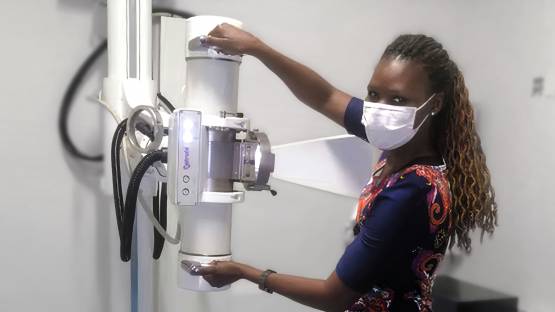Cancer cases are on the rise in Namibia, including skin cancer – but thanks to a new machine recently donated to the country by the IAEA, improved treatment options are now available.
One of the main causes of skin cancer is the sun’s harmful ultraviolet rays. This triggers mutations which cause the skin cells to multiply and form tumours. If detected early enough, many skin cancers can be treated with little scarring and with high chances of total elimination.
Skin cancer and related cancers, such as Kaposi sarcoma in particular, rank as one of the leading forms of cancer in Namibia. “Year in and year out, I see that the number of cases is increasing, showing that skin cancer is not rare within sub-Saharan Africa,” said Laina Iiyambo, clinical and radiation oncologist at Windhoek Central Hospital. “It is necessary to strengthen our radiotherapy services and help reduce these cases.”
In late 2021 the IAEA delivered a new orthovoltage radiotherapy machine — a machine that uses radiation to kill cancer cells — to Namibia’s Windhoek Central Hospital in the country’s capital. As a result, over 600 skin cancer patients per year can now receive medical care for skin cancer.
Before the machine was delivered, patients with skin and other superficial cancers in Namibia were treated with more penetrating radiation beams that are usually used to treat deeper seated cancers. These machines can increase the radiation dose in underlying healthy tissue, potentially harming it.
The arrival of the new machine in the public sector will allow Namibian oncologists, like Iiyambo, to offer treatment to more patients, which in particular will benefit people with limited access to care.
“The new machine will allow skin cancer patients to receive effective and affordable treatment while significantly cutting their waiting time,” said Anna Grigoryan, the IAEA programme management officer coordinating the activities with Namibia through the technical cooperation programme. “To provide optimal care for those patients, standardised guidelines and innovative modalities for skin cancer prevention, treatment and diagnosis are important.”
While in many sub-Saharan African countries’ cases of breast, cervix, prostate and Kaposi sarcoma cancer are dominant, Namibia has a particularly high incidence of albinism, which is an absence of pigmentation or colouration in an individual, leading to light skin, hair and eyes. Albinism is associated with a higher risk of skin cancers. The country has the highest number of people with albinism per capita in the world, making skin cancer care even more important for the country.







